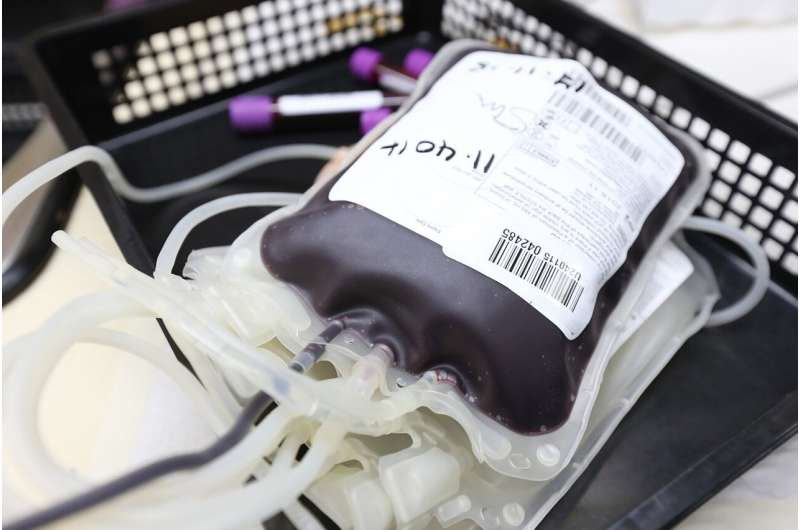This article has been reviewed according to Science X's editorial process and policies. Editors have highlighted the following attributes while ensuring the content's credibility:
fact-checked
peer-reviewed publication
trusted source
proofread
Transfusing more blood may benefit patients who have had heart attack and have anemia

An international clinical trial led by physician Jeffrey L. Carson, distinguished professor of medicine at Rutgers Robert Wood Johnson Medical School, found that a liberal blood transfusion given to patients who have had a heart attack and have anemia may reduce the risk of a reoccurrence and improve survival rates.
The results of the trial, Myocardium Infarction and Transfusion (MINT), were published in the New England Journal of Medicine. Maria Mori Brooks, professor of epidemiology and biostatistics at the University of Pittsburgh School of Public Health, co-first authored the study.
"Transfusion threshold trials are important to help physicians inform decisions that provide the most benefit for their patients," said Carson. "The goal of the MINT trial was to establish evidence that can be used to set transfusion standards for patients who have had a heart attack, to improve their rate of survival and reduce the risk of additional heart attacks."
The MINT trial evaluated two transfusion strategies in more than 3,500 enrolled participants at 144 hospitals in six countries. Half of the participants in the study were given more blood to keep their blood count greater than 10 grams per deciliter (g/dL), considered a liberal transfusion strategy.
Half didn't receive blood unless their blood count was less than eight g/dL, the restrictive transfusion strategy. All patients in the study had a heart attack and anemia, meaning they had a hemoglobin blood count of less than 10 g/dL. A normal blood count is 12 to 13 g/dL.
"The results of the MINT trial indicate that a liberal strategy of blood transfusion may improve outcomes in anemic patients with heart attacks without causing undue harm," Carson said.
The results of the multicenter randomized clinical trial were presented at the Late-Breaking Scientific Sessions of the 2023 American Heart Association annual conference.
A large percentage of patients had suffered a previous heart attack, heart failure, diabetes or kidney disease. The average age of participants was 72, with 45 percent being women.
Although the transfusion strategy was randomly assigned, health professionals caring for patients at hospitals had clinical discretion to adhere to the study to ensure standard of care for their patients.
The researchers compared the frequency of the main outcome of death or recurrent heart attack at 30 days after enrollment into the trial. Although not statistically significant, the study found the frequency of mortality or recurrent heart attack was 2.4 percent lower when a liberal approach was used.
Brooks, the principal investigator of the data coordinating center for the MINT trial, with 3,500 patients, said MINT provides the best data available to answer an important question that physicians face every day.
"The trial results indicate that the liberal strategy may be better, but they also suggest that the two approaches may be similar. These results challenge us to dig deeper," Brooks said. "Do some patients benefit more than others? And why? Answering those questions will be our next steps."
For nearly two decades, Carson has studied the implications of red blood cell transfusion strategies toward providing optimal treatment for patients. His work helped establish transfusion guidelines in 2012 used by physicians to inform patient care, updates to which were announced last month in the Journal of the American Medical Association emphasizing an individualized approach in adults and children that account for comorbid conditions.
Carson and the study team stress that further clinical trials, meta-analyses of studies and additional analysis of the MINT trial data are critical to ensuring physicians are informed with the best evidence when considering when to transfuse patients who had a heart attack and have anemia.
More information: Jeffrey L. Carson et al, Restrictive or Liberal Transfusion Strategy in Myocardial Infarction and Anemia, New England Journal of Medicine (2023). DOI: 10.1056/NEJMoa2307983



















